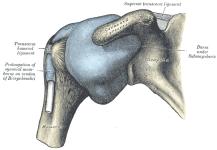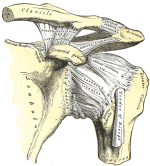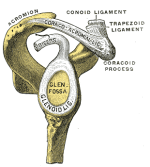N
Naughty Nurse
Guest
The shoulder-joint is an enarthrodial or ball-and-socket joint. The bones entering into its formation are the hemispherical head of the humerus and the shallow glenoid cavity of the scapula, an arrangement which permits of very considerable movement, while the joint itself is protected against displacement by the tendons which surround it.
The ligaments do not maintain the joint surfaces in apposition, because when they alone remain the humerus can be separated to a considerable extent from the glenoid cavity; their use, therefore, is to limit the amount of movement. The joint is protected above by an arch, formed by the coracoid process, the acromion, and the coracoacromial ligament. The articular cartilage on the head of the humerus is thicker at the center than at the circumference, the reverse being the case with the articular cartilage of the glenoid cavity. The ligaments of the shoulder are:
The Articular Capsule
The Glenohumeral
The Coracohumeral
The Transverse Humeral
The Glenoidal Labrum
Gray's Anatomy; Bartleby.com
FYI: If you would like to make out the printing, click open the attachment....when it's open, simply let your cursor sit on it, and there should be a box with arrows that appear showing outwards...click on that and the image should be larger.
The ligaments do not maintain the joint surfaces in apposition, because when they alone remain the humerus can be separated to a considerable extent from the glenoid cavity; their use, therefore, is to limit the amount of movement. The joint is protected above by an arch, formed by the coracoid process, the acromion, and the coracoacromial ligament. The articular cartilage on the head of the humerus is thicker at the center than at the circumference, the reverse being the case with the articular cartilage of the glenoid cavity. The ligaments of the shoulder are:
The Articular Capsule
The Glenohumeral
The Coracohumeral
The Transverse Humeral
The Glenoidal Labrum
Gray's Anatomy; Bartleby.com
FYI: If you would like to make out the printing, click open the attachment....when it's open, simply let your cursor sit on it, and there should be a box with arrows that appear showing outwards...click on that and the image should be larger.



